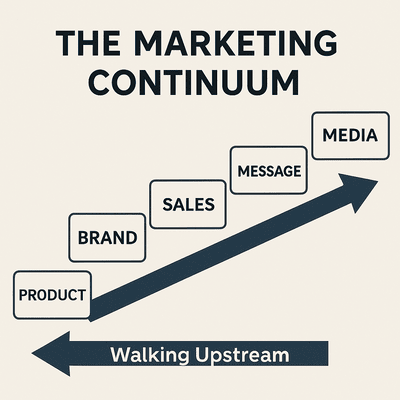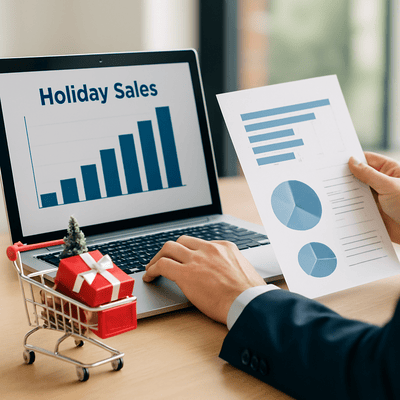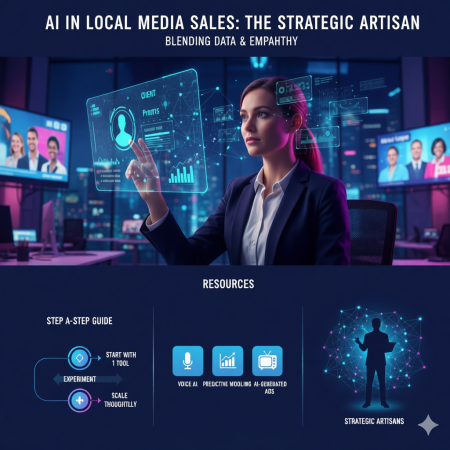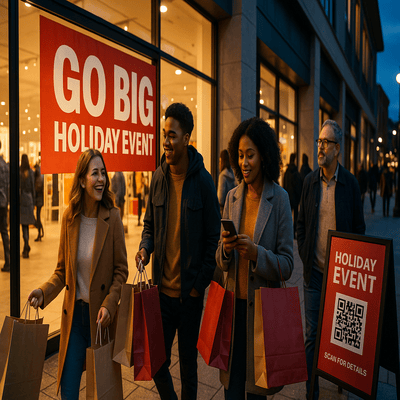Understand The Client Continuum
Most media sellers show up to renewal meetings eager to talk schedules and impressions, while their clients are preoccupied with upstream issues like market share, competition, and sales performance. This article introduces the “Marketing Continuum” — Product, Brand, Sales, Message, Media — to explain why advertisers live upstream while radio and other media live at the far end. Because of this gap, many renewal conversations are misaligned, with sellers pushing media solutions while clients are still wrestling with deeper business questions. Sellers who deliberately “walk upstream” by asking thoughtful questions about the client’s current challenges shift the dialogue from “Do you need a Q1 schedule?” to “What are you trying to achieve right now?”. Over time, this upstream posture transforms them from vendors into trusted thought partners, earning earlier visibility into plans and larger, more strategic opportunities.
In-Store Shopping: Critical Channel for Holiday Sales Season
Physical retail maintains strong pull despite e-commerce growth, offering local media and agencies key targeting opportunities.
Despite e-commerce growth, 76% of consumers consider in-store shopping a holiday ritual, with three-quarters saying it's essential to feeling festive and connected. Physical stores drive higher-value purchases, as 70% of shoppers feel more comfortable buying premium items in-store versus 30% online, while 72% trust in-store quality more than online options. The research challenges Black Friday's effectiveness, with 84% of consumers preferring deals spread throughout November and December rather than concentrated one-day events. For local media sales reps and agencies, the data suggests opportunities in sustained promotional campaigns, experiential retail messaging, and targeting Gen Z shoppers who show the strongest affinity for in-store discovery.
Consumers Plan Near-Record Holiday Spend; Local Media & Agencies Should Adjust Strategy
Consumers plan to spend an average of $890.49 this holiday season—the second-highest level in 23 years—despite concerns about tariffs and rising prices. About $628 will go toward gifts, showing budgets remain strong even as shoppers grow more value-conscious. While 42% begin browsing before November, 63% plan to buy mainly over Thanksgiving weekend, with 60% finishing in December. Online leads all channels (55%), followed by grocery, department, and discount stores, underscoring the need for integrated digital and local strategies. For local media and agencies, success will hinge on value-driven, well-timed, and locally relevant campaigns that blend digital precision with community connection.
2026: A Look Into The Future and What It Means for Your Local Media and Marketing
The 2025 Marketing Brew Summit revealed that agility is now the defining skill in marketing, with 87% of marketers calling it essential as the industry rapidly evolves toward 2026. Marketers are shifting focus from AI upskilling to experimenting with new channels—especially social, influencer, and emerging platforms—while simultaneously prioritizing better attribution and outcome-based measurement. Despite this ambition, most teams remain under-resourced and structurally slow, forcing marketers to “do more with less” and improvise speed within rigid systems. For local media sales teams and agencies, the insights signal opportunity: agile local campaigns, modular testing packages, and measurable ROI can outperform national one-size-fits-all models. The future of local marketing success will depend on turning experimentation into strategy, measurement into proof, and community engagement into long-term brand value.
What Local Media, Ad Agencies, and Advertisers Can Learn from National Campaigns
National advertising campaigns offer valuable lessons for local media, ad agencies, and advertisers—especially in the areas of consistency, emotional storytelling, and omnichannel strategy. By studying how major brands build Top-of-Mind Awareness (TOMA), use data to target audiences, and measure results, local marketers can apply similar principles at a smaller scale. Emotional resonance, community influencers, and purpose-driven messaging are just as powerful locally as they are nationally. Tools like co-op advertising, AI-driven creative, and cross-platform media planning can help local businesses compete more effectively. Ultimately, the key takeaway is this: think like a national brand, but act with local insight and agility.
The Gift: Turning Holiday Shopper Stress Into Local Media Sales Opportunity
Holiday shopping stress is surging, with 84% of consumers abandoning carts due to feeling overwhelmed, according to Accenture’s 2025 Holiday Shopping Survey. Younger shoppers are especially prone, with 89% of Gen Z and 91% of millennials reporting they walk away from purchases. The survey also found 82% of consumers feel overwhelmed by advertising and 77% cite too many options, up sharply from prior years. While this poses a risk to retailers, it also presents an opportunity for local merchants to stand out by simplifying choices, highlighting human expertise, and creating stress-free shopping experiences. For local media sales reps and agencies, the key is positioning clients as solution providers, using advertising that cuts through the noise with clarity, trust, and confidence.
CPMs Stabilize as Holiday Season Nears: A Signal for Local Sellers
Digital ad spending is showing signs of recovery, with display retargeting and prospecting CPMs rebounding significantly in Q3, according to AdRoll. AI-driven traffic to retail sites has surged over 4, 700% year-over-year, signaling a major shift in how consumers discover products. Marketers are being urged to invest earlier—September and October—to build brand recognition ahead of the holiday season. For local media sales teams and agencies, this presents an opportunity to pitch awareness-focused campaigns across connected TV, radio, and digital. The takeaway: early, visibility-driven advertising strategies could secure more revenue as advertiser confidence returns.
The Steadily Rising Power of U.S. Latinos: What Local Media and Ad Agencies Need to Know
The U.S. Latino economy now produces roughly $3.6 trillion in annual GDP, making it one of the world’s largest and fastest-growing markets. Within that growth, Latinas (Hispanic women) contribute about $1.3 trillion in economic output and drive most household purchasing decisions. Younger cohorts—Gen Z and Gen Alpha—are highly bilingual, racially mixed, and expect brands to demonstrate authenticity and cultural relevance. Hispanic households show wide diversity in country of origin, language use, and multigenerational structure, demanding more nuanced marketing than one-size-fits-all campaigns. For local media sales teams and ad agencies, tailoring content and ad packages to these demographic, cultural, and technological shifts is critical to capturing a rapidly expanding share of consumer spending.
Local Media’s Moment: Blending Data and Magic to Win Retail Ad Dollars
Retailers are under pressure to combine data-driven efficiency with the emotional “magic” of storytelling to win today’s fickle consumers. Local media reps and advertising agencies can capitalize by packaging omnichannel campaigns that integrate predictive analytics, local market data, and authentic creative.
By offering measurable results—such as foot-traffic lift, in-store sales, and online conversions—media sellers move from simple vendors to strategic partners. Authentic, community-based storytelling and experiential activations help local brands differentiate and avoid the “race to the bottom” on price. Those who embrace this data + magic model can capture larger budgets, strengthen client relationships, and increase their own revenue in a rapidly evolving retail landscape.
Holiday Sales 2025: Retailers Told to "Go Big" as Consumers Weigh Value and Experience
Holiday sales in 2025 are projected to rise 4% to more than $975 billion, a healthy but below-average pace as consumers balance rising wages with debt and economic uncertainty.
Bain Company advises retailers to “go big” with bold, event-driven promotions—especially around Black Friday and Cyber Monday—as cautious shoppers still flock to high-impact sales moments.
In-store spending is expected to gain 2.75% while e-commerce growth slows to 7%, making an integrated digital-plus-brick strategy essential.
Retailers that highlight value, deliver warm in-person experiences, and use timely, personalized ads are most likely to outperform.
For local media reps and ad agencies, the forecast is a call to action to pitch concentrated campaigns, bundle traditional with digital, and help clients turn calculated consumers into confident buyers.
The Psychology of Weather: Unlocking Local Advertising Power
Research from The Weather Company and Neuro-Insight shows that weather directly influences consumer memory, emotions, and purchase intent. They identified three “weather mindsets”—Creating (sunny), Relishing (cloudy), and Enduring (stormy)—each of which changes how people engage with advertising. Campaigns aligned with these mindsets can lift purchase intent by 10% or more, with detail memory strongly linked to buying behavior. Local media outlets and agencies can leverage these insights by timing creative, pricing inventory, and crafting messages that match real-time conditions. By integrating weather data into planning and measurement, sellers can differentiate their offerings and drive stronger results for local advertisers.
Political Ad Spending Poised to Shatter Midterm Records in 2026 — What It Means for Local Media and Agencies
Political ad spending is projected to reach $10.8 billion in 2026, making it the most expensive midterm cycle in U.S. history. Broadcast TV will still capture nearly half of this spending, but Connected TV (CTV) will surge to $2.5 billion, reshaping campaign strategies and demanding integrated media solutions. Swing states like California, Michigan, Texas, Georgia, and North Carolina will see the heaviest demand, with inventory scarcity and premium pricing affecting both political and non-political advertisers. Early buying is already breaking records, meaning agencies and local reps must help clients secure placements well in advance. For local media and agencies, the opportunity lies in balancing short-term political windfalls with long-term client relationships through cross-platform strategies and consultative selling.
The Death of Size as Competitive Advantage: How Small Agencies Can Beat Big Players
Artificial intelligence and programmatic advertising platforms are dismantling traditional competitive advantages of large agencies by democratizing access to sophisticated tools once exclusive to major players. Boutique agencies are leveraging this technological leveling to outperform larger competitors through specialized expertise and faster decision-making, with some achieving better performance metrics than multinational networks. Specialization allows smaller firms to command premium pricing while delivering personalized service and direct access to senior strategists. Speed has become critical, as boutique agencies pivot strategies within hours compared to weeks of approval processes at larger firms. The trend strongly favors agile specialists who combine technological fluency with deep domain expertise and exceptional client relationships.
Holiday Tightrope: Consumers Pull Back as Gen Z Leads a Spending Slowdown
Consumers are tightening their wallets this holiday season, with overall spending projected to decline 5% from 2024—the first drop since 2020. Gen Z is pulling back the most, slashing budgets by 23% after last year’s surge, signaling how quickly sentiment can shift. A compressed holiday calendar means nearly 80% of budgets will be spent by Cyber Monday, putting urgency on front-loaded campaigns. Value is the dominant theme, with shoppers gravitating toward discounts, gift cards, and practical purchases, while tariffs and economic uncertainty further dampen confidence. For local media reps and agencies, the opportunity lies in helping clients pivot messaging toward affordability, convenience, and community trust to capture cautious but still motivated holiday shoppers.
Retail Therapy Is Real—And It’s a Signal Local Media Sales Reps Shouldn’t Ignore
Retail therapy—the act of shopping to improve mood—is a scientifically supported behavior that offers emotional relief by restoring a sense of control, especially during times of sadness or stress. Research shows that the process of choosing and browsing, not just purchasing, triggers dopamine and serotonin, making consumers more receptive to emotionally resonant advertising. Local businesses, with their in-person experiences and human touch, are uniquely positioned to benefit from this behavior, especially when their ads emphasize comfort, self-care, and personal connection. For media sales reps, this presents a strategic opportunity to guide clients toward emotionally intelligent messaging and contextual ad placements. When done responsibly, advertising that aligns with retail therapy can drive results while supporting consumer well-being.















